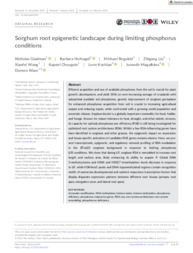Sorghum root epigenetic landscape during limiting phosphorus conditions.
Sorghum root epigenetic landscape during limiting phosphorus conditions.
Autoria: GLADMAN, N.; HUFNAGEL, B.; REGULSKI, M.; LIU, Z.; WANG, X.; CHOUGULE, K.; KOCHIAN, L.; MAGALHAES, J. V. de; WARE, D.
Resumo: Efficient acquisition and use of available phosphorus from the soil is crucial for plant growth, development, and yield. With an ever-increasing acreage of croplands with suboptimal available soil phosphorus, genetic improvement of sorghum germplasm for enhanced phosphorus acquisition from soil is crucial to increasing agricultural output and reducing inputs, while confronted with a growing world population and uncertain climate. Sorghum bicolor is a globally important commodity for food, fodder, and forage. Known for robust tolerance to heat, drought, and other abiotic stresses, its capacity for optimal phosphorus use efficiency (PUE) is still being investigated for optimized root system architectures (RSA). Whilst a few RSA-influencing genes have been identified in sorghum and other grasses, the epigenetic impact on expression and tissue-specific activation of candidate PUE genes remains elusive. Here, we present transcriptomic, epigenetic, and regulatory network profiling of RSA modulation in the BTx623 sorghum background in response to limiting phosphorus (LP) conditions. We show that during LP, sorghum RSA is remodeled to increase root length and surface area, likely enhancing its ability to acquire P. Global DNA 5-methylcytosine and H3K4 and H3K27 trimethylation levels decrease in response to LP, while H3K4me3 peaks and DNA hypomethylated regions contain recognition motifs of numerous developmental and nutrient responsive transcription factors that display disparate expression patterns between different root tissues (primary root apex, elongation zone, and lateral root apex).
Ano de publicação: 2022
Tipo de publicação: Artigo de periódico
Unidade: Embrapa Milho e Sorgo
Palavras-chave: Cromatina, DNA, Deficiência, Fósforo, Metilação, Sistema Radicular, Sorghum Bicolor, Sorgo
Observações
1 - Por padrão são exibidas publicações dos últimos 20 anos. Para encontrar publicações mais antigas, configure o filtro ano de publicação, colocando o ano a partir do qual você deseja encontrar publicações. O filtro está na coluna da esquerda na busca acima.
2 - Para ler algumas publicações da Embrapa (apenas as que estão em formato ePub), é necessário ter, no celular ou computador, um desses softwares gratuitos. Sistemas Android: Google Play Livros; IOS: iBooks; Windows e Linux: software Calibre.
Acesse outras publicações
Acesse a Base de Dados da Pesquisa Agropecuária (BDPA) para consultar o acervo completo das bibliotecas da Embrapa.

